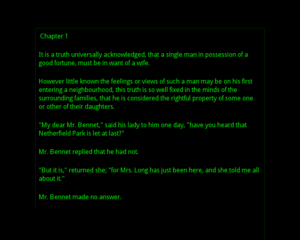PyRoom
 | |
| Developer(s) | The PyRoom Team |
|---|---|
| Stable release | 0.4.1
/ April 29, 2009 |
| Engine | |
| Operating system | Unix-like |
| Type | Text editor |
| License | GPLv3 |
| Website | github |
![]() Search PyRoom on Amazon.
Search PyRoom on Amazon.
PyRoom is a full-screen writing program, i.e. a full-screen text editor with the purpose of isolating the user from the operating system and other applications. Written using the GTK+ widget toolkit, PyRoom is a clone of the WriteRoom text editor and features "distraction-free writing".[1] Because PyRoom takes up the whole screen, it is "without buttons, widgets, formatting options, menus and with only the minimum of required dialog windows". It is keyboard oriented and can be configured.
Pyroom supports the following keyboard commands:[2][3]
- Ctrl+H - Show help in a new buffer
- Ctrl+I - Show buffer information
- Ctrl+P - Shows Preferences dialog
- Ctrl+N - Create a new buffer
- Ctrl+O - Open a file in a new buffer
- Ctrl+Q - Quit
- Ctrl+S - Save current buffer
- Ctrl+⇧ Shift+S - Save current buffer as
- Ctrl+W - Close buffer and exit if it was the last buffer
- Ctrl+Y - Redo last typing
- Ctrl+Z - Undo last typing
- Ctrl+Page Up - Switch to previous buffer
- Ctrl+Page Down - Switch to next buffer
Some use of "" in your query was not closed by a matching "".Some use of "" in your query was not closed by a matching "".
References[edit]
- ↑ "PyRoom - distraction free writing". 2008-11-01.
- ↑ Pyroom v0.4.1 Ctrl+H keyboard shortcut
- ↑ "~pyroom-dev/pyroom/trunk : /README". Launchpad. Retrieved 2018-08-29.
External links[edit]
This article "PyRoom" is from Wikipedia. The list of its authors can be seen in its historical and/or the page Edithistory:PyRoom. Articles copied from Draft Namespace on Wikipedia could be seen on the Draft Namespace of Wikipedia and not main one.

